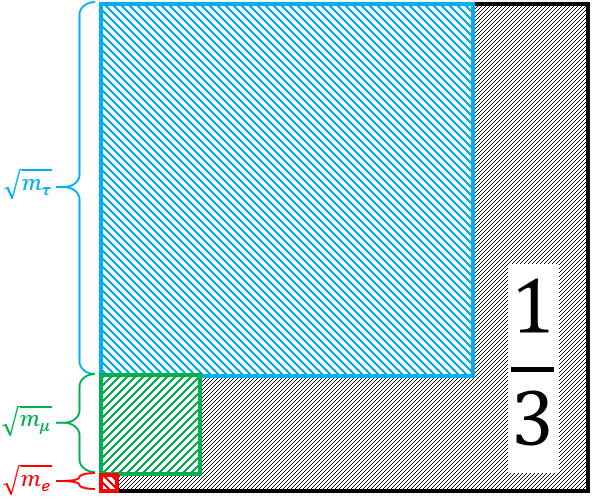
The Koide formula is an unexplained
empirical equation
In science, an empirical relationship or phenomenological relationship is a relationship or correlation that is supported by experiment and observation but not necessarily supported by theory.
Analytical solutions without a theory
An empirical rel ...
discovered by
Yoshio Koide in 1981. In its original form, it relates the masses of the three charged
lepton
In particle physics, a lepton is an elementary particle of half-integer spin (spin ) that does not undergo strong interactions. Two main classes of leptons exist: charged leptons (also known as the electron-like leptons or muons), and neutr ...
s; later authors have extended the relation to
neutrino
A neutrino ( ; denoted by the Greek letter ) is a fermion (an elementary particle with spin of ) that interacts only via the weak interaction and gravity. The neutrino is so named because it is electrically neutral and because its rest mass ...
s,
quark
A quark () is a type of elementary particle and a fundamental constituent of matter. Quarks combine to form composite particles called hadrons, the most stable of which are protons and neutrons, the components of atomic nuclei. All commonly ...
s, and other
families of particles.
Formula
The Koide formula is
:
where the masses of the
electron
The electron ( or ) is a subatomic particle with a negative one elementary electric charge. Electrons belong to the first generation of the lepton particle family,
and are generally thought to be elementary particles because they have n ...
,
muon
A muon ( ; from the Greek letter mu (μ) used to represent it) is an elementary particle similar to the electron, with an electric charge of −1 '' e'' and a spin of , but with a much greater mass. It is classified as a lepton. As w ...
, and
tau are measured respectively as = , = , and = ; the digits in parentheses are the
uncertainties in the last digits.
[
] This gives = .
No matter what masses are chosen to stand in place of the electron, muon, and tau, The upper bound follows from the fact that the square roots are necessarily positive, and the lower bound follows from the
Cauchy–Bunyakovsky–Schwarz inequality. The experimentally determined value, , lies at the center of the mathematically allowed range. But note that removing the requirement of positive roots it is possible to fit an extra tuple in the quark sector (the one with strange, charm and bottom).
The mystery is in the physical value. Not only is the result peculiar, in that three ostensibly arbitrary numbers give a simple fraction, but also in that in the case of electron, muon, and tau, is exactly halfway between the two extremes of all possible combinations: (if the three masses were equal) and 1 (if one mass dominates).
Robert Foot also interpreted the Koide formula as a geometrical relation, in which the value
is the squared cosine of the angle between the vector
 The Koide formula is an unexplained
The Koide formula is an unexplained  The Koide formula is an unexplained
The Koide formula is an unexplained